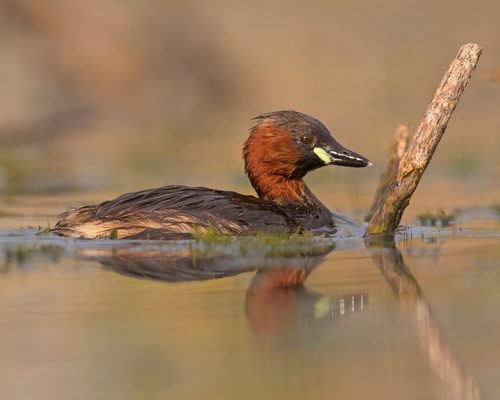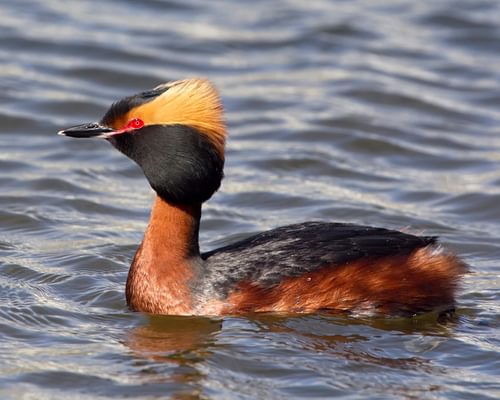Black-necked Grebe
Least ConcernPodiceps nigricollis
Visual Identification
Appearance
The Black-necked Grebe is a small waterbird with distinctive breeding plumage. It displays a black head and neck in summer, contrasting sharply with its bright chestnut flanks. The eyes are deep red, accentuated by golden ear tufts.
The plumage becomes duller in winter, with a white throat and grayish-black upper parts. Juveniles resemble non-breeding adults but with striped faces.
Size
Length
28cm to 34cm
Wingspan
56cm to 60cm
Weight
200g to 450g
Colours
Males and females have similar plumage
Primary Colour
Black White
Secondary Colour
Red Yellow
Beak Colour
Black
Leg Colour
Black
Habitat and Distribution
Habitats
Woodland
Garden
Wetland
Coastal
Urban
Farmland
Grassland
Desert
Tundra
Rainforest
Mountain
Savanna
Distribution
Black-necked Grebes inhabit freshwater lakes, marshes, and coastal lagoons across Europe, Asia, Africa, and the Americas. They prefer shallow, productive waters with abundant aquatic vegetation for nesting and foraging.
In North America, they are known as Eared Grebes and are common in western states. They are scarce breeders in the UK but more numerous in winter, particularly along the south coast.
Elevation Range
Sea level to 2,500 meters
Climate zones
Temperate, Subtropical
Distribution Map
This map gives you a rough idea of where you might spot a Black-necked Grebe. The coloured areas show countries where these birds have been seen.
A few things to keep in mind:
- Birds might not be everywhere in the coloured areas, for example, they may be present around the coast of that country
- Where birds live can change with seasons and available food
- This map is quite simple - it doesn't show exact locations
We're working on making our maps even better! Soon, we hope to show you:
- More detailed maps for bigger countries, including state and region
- How birds move around during different seasons
Distribution by Region
Behaviour and Ecology
Bird Attributes
This feature is in beta. We'd love your feedback to improve it!
Share your thoughtsBird Attributes Explained
Our bird attributes system rates various aspects of a bird's capabilities on a scale of 0-100, based on data from field observations, scientific studies, and expert knowledge.
Attribute Categories:
- Agility: Manoeuvrability, speed, and grace in flight or movement.
- Strength: Physical power, often correlating with size and hunting abilities.
- Adaptability: Ability to thrive in various environments or changing conditions.
- Aggressiveness: Territorial behaviour and assertiveness, particularly during breeding seasons.
- Endurance: Stamina, often seen in migration patterns or foraging behaviours.
Understanding the Ratings:
- 0-20: Very Low
- 21-40: Low
- 41-60: Average
- 61-80: High
- 81-100: Very High
Remember, these attributes are relative to other bird species and don't necessarily indicate superiority.
Hover over the icon next to each attribute for more information.
Tap the icon next to each attribute for more information.
Agility
Reflects the bird's manoeuvrability, speed, and grace in flight or movement.
The Black-necked Grebe demonstrates remarkable agility in water, with excellent swimming and diving abilities. Their capacity to submerge for up to 30 seconds and perform elaborate synchronized swimming displays during courtship indicates high manoeuvrability and control.
Strength
Indicates the bird's physical power, often correlating with size and hunting abilities.
While adept swimmers, Black-necked Grebes are small waterbirds with a weight range of 200-450g. Their strength is sufficient for their aquatic lifestyle and migration, but not exceptional compared to larger bird species.
Adaptability
Represents the bird's ability to thrive in various environments or changing conditions.
These grebes show considerable adaptability, inhabiting a wide range of elevations from sea level to 2,500 metres. Their ability to thrive in various freshwater and coastal environments across multiple continents, coupled with their night migration using celestial navigation, demonstrates strong adaptive capabilities.
Aggressiveness
Measures the bird's territorial behaviour and assertiveness, particularly during breeding seasons.
Black-necked Grebes are generally not aggressive birds. They are highly social, often forming large flocks outside the breeding season. While they may defend nesting territories, there's no indication of notable aggression in their behaviour.
Endurance
Reflects the bird's stamina, often seen in migration patterns or foraging behaviours.
The endurance of Black-necked Grebes is evident in their migratory behaviour and diving abilities. Their capacity for long-distance night migrations and the ability to dive frequently for foraging suggest good stamina. However, as small birds, their endurance has limits compared to larger migratory species.
Diet
Black-necked Grebes primarily feed on aquatic insects, small fish, and crustaceans (particularly brine shrimp).
They hunt by diving underwater, using their feet for propulsion and sharp beak to catch prey. During migration, they may also consume their own feathers to aid in digestion.
Behaviour
Black-necked Grebes are highly social, often forming large flocks outside the breeding season. They are excellent swimmers and divers, frequently submerging for up to 30 seconds while foraging.
During courtship, pairs engage in elaborate synchronized swimming displays, mirroring each other's movements.
Vocalisation
Black-necked Grebes are generally quiet outside the breeding season. During courtship and nesting, they produce a variety of calls, including a high-pitched 'whee-oo' and a soft 'poo-eee-chk'. Alarm calls are described as a sharp, repeated 'pik-pik-pik'.
Nesting & Breeding
Breeding typically occurs from May to August, with pairs forming on arrival at breeding sites. Black-necked Grebes are monogamous during the breeding season and often return to the same nesting areas annually.
Nests are floating platforms of aquatic vegetation anchored to emergent plants. Females usually lay 3-4 pale blue eggs, which become stained brown over time.
Both parents incubate the eggs for about 21 days. Chicks are precocial, able to swim shortly after hatching, and are often seen riding on their parents' backs for protection.
Lifespan
The Black-necked Grebe typically lives for 7 years, with a maximum recorded lifespan of 13.1 years.
Like all birds, lifespan can be affected by factors including predation, habitat quality, disease, and access to food sources.
Conservation and Status
Global Conservation Status
While globally listed as Least Concern, Black-necked Grebes face localized threats from habitat loss and pollution.
Conservation efforts focus on protecting wetland habitats and monitoring population trends, particularly in areas where numbers have declined.
Population Data
Global Population Estimate
3,900,000 - 4,200,000 mature individuals [3]
Global Population Trend
Trend data may be uncertain or fluctuating
Birdwatching Tips
- Look for Black-necked Grebes on inland lakes and coastal bays
- Observe their distinctive diving behavior, often disappearing suddenly
- In breeding season, watch for their elaborate courtship displays
- Use a spotting scope for better views, as they often stay far from shore
Additional Information
Quick Facts
Other names:
Eared Grebe
Family:
PodicipedidaePredators
Main predators include large fish, birds of prey such as harriers and gulls, and mammals like foxes and minks, particularly targeting eggs and young.
Did You Know?
- Black-necked Grebes can adjust their buoyancy to sink vertically in water, with only their head visible.
- They migrate at night, using stars for navigation.
- These grebes eat their own feathers, which may help protect their digestive system from sharp fish bones.
Was this bird profile helpful?
Your feedback helps us improve our content
Thanks for your feedback!
Your input helps us improve our content.
Community Experience
Community Ratings
No ratings yet - be the first to rate this bird!
Latest Community Reviews
No reviews yet
Sign in to be the first to review
Community Reviews
Create Your Free Account Welcome Back!
Join our community to rate birds and share your experiences. Creating an account is completely free and only takes a minute. Sign in to your account to rate birds and share your experiences with our community.
Your information is secure and will never be shared.
By creating an account, you agree to our Privacy Policy.
Similar Birds
References
- 2
website: BirdLife International. 2018. Podiceps nigricollis. The IUCN Red List of Threatened Species 2018: e.T22696610A132584321.
View source - 3
report, 2015: Wetlands International
- 1
website, 2010: Fransson et al., EURING list of longevity records for European birds
View source

